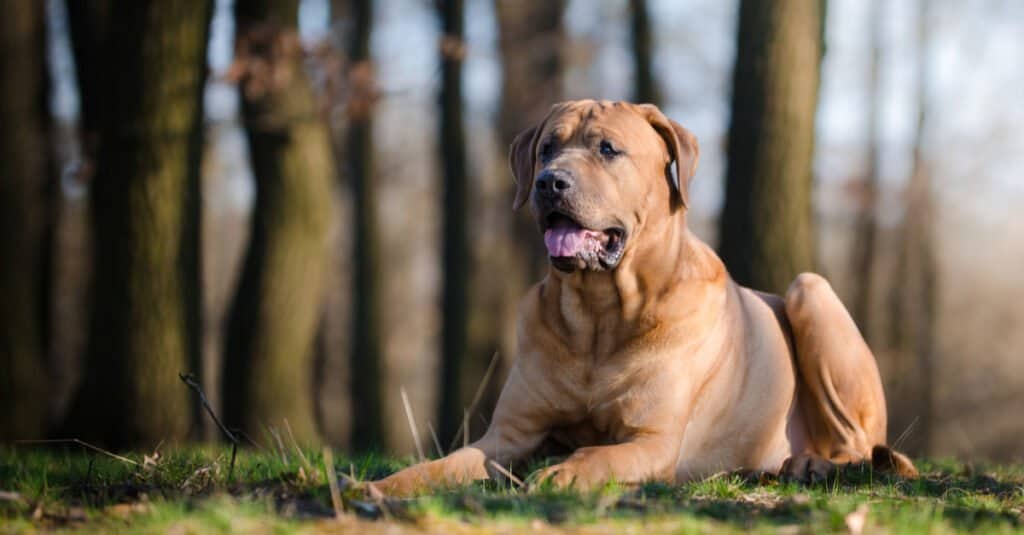Tosa
Canis lupus
Advertisement
Tosa Scientific Classification
- Kingdom
- Animalia
- Phylum
- Chordata
- Class
- Mammalia
- Order
- Carnivora
- Family
- Canidae
- Genus
- Canis
- Scientific Name
- Canis lupus
Read our Complete Guide to Classification of Animals.
Tosa Conservation Status
Tosa Facts
The tosa is a member of Japan’s long tradition of dog fighting, which stretches back to the 14th century. The island of Shikoku was the nonpareil home of dogfighting before Westerners came on the scene. After Commodore Perry arrived in 1854, Japanese dogfighters began mixing the genetics of foreign dogs with native pups. The tosa was one such hybrid, descending from local Shikoku inu (dogs) and Western breeds like mastiffs, bulldogs, and Great Danes.
Despite their fighting background, tosas are sweet, patient dogs with relaxed, obedient temperaments. These brave dogs stand tall and stately as the largest of Japan’s dog breeds and are ever-watchful, happy to serve as protective watchdogs for their families. Normally tranquil, tosas can sometimes be aloof with strangers or those it considers intruders. They come in fawn, apricot, brindle, or black colorings with occasional white markings on their paws or chest.
Read on to learn about tosas and what to know before adopting one into your family.
Tosas were named for the Tosa Province on Shikoku and are considered the dog equivalent of Sumo wrestlers.
The Best Dog Food For Tosa
Whether you go with dry food or raw, homemade recipes, tosas require high-quality dog food that fulfills its nutritional and energy needs. A vet can provide individualized guidance on the best food for your pup. Still, most tosas have similar dietary requirements, requiring high levels of proteins and plenty of healthy fats, vitamins, and minerals for good health. Depending on your dog’s age, you should give him different formulas for the puppy, adult, and senior stages of his life.
As muscle-bound, large dogs designed for combat, tosas need lots of protein to encourage the healthy development of lean mass. These larger dogs can be susceptible to joint issues, which recipes with supplements like glucosamine and chondroitin help prevent and soothe. We at A-Z Animals recommend Orijen Original Grain-Free Dry Dog Food for Giant Breeds, as it’s formulated to help larger dogs’ precise nutritional needs. The recipe is as follows:
- 85% animal ingredients for protein, minerals, and vitamins.
- Full of nutrient-rich organs to fit a whole prey diet.
- USA-made and freeze-dried for extra flavor.
Trainers should also be conservative with treats, as tosas are prone to weight gain and obesity. While valuable tools for training, breaking a single treat into multiple pieces will stave off the weight and be just as effective as positive reinforcement. Also, make sure your tosa has access to clean, fresh water at all times.
3 Pros and Cons of Owning a Tosa
***
| Pros! | Cons! |
| Calm and tranquil Tosas rarely bark or act up, happy to laze away the day. | Wary of strangers These dogs can be aloof and watchful of newcomers. |
| Minimal grooming The Tosa only needs minimal brushing and the occasional bath. | Too big for small children These large dogs might accidentally crush small kids. |
| Healthy with low medical maintenance These pups have no common medical issues. | Aggressive with other animals The tosa’s fighting nature can make them sometimes naturally aggressive with other dogs. |
Tosa Size and Weight
These stout dogs are tall, regal, and, most of all, heavy. Females can weigh between 90 to 140 pounds and range in height between 22-28 inches. Males are even larger, weighing 130-200 pounds at full maturity and standing between 24-32 inches.
| Height (Male) | 32’ Tall |
| Height (Female) | 28’ Tall |
| Weight (male) | 200lbs, fully grown |
| Weight (female) | 140lbs, fully grown |
Tosa Common Health Issues
Most tosas are healthy with no commonly reported health issues, whether genetic or generally common to the breed. Some individuals can face challenges typical of giant breed dogs, such as hip or elbow dysplasia or gastric torsion, otherwise known as bloat. By working with a responsible breeder, potential owners can learn what health concerns may arise when owning a pup and how to mitigate or alleviate any future issues.
Tosa Temperament
Fearless, gentle giants, tosas are quiet-natured dogs loyal, loving, and protective of their families. They ask for an owner with authority who can provide a clear, rules-based structure and be someone to turn to in new situations.
By nature, the tosa can be cautious when meeting strangers and potentially aggressive with new animals and dogs. Trainers with a firm hand who socialize their dog early on will go a long way to making them more welcoming of new people.
How To Take Care of Tosa

Tosa dogs respond the best to positive-reinforcement training, with plenty of treats and encouragement.
©TMArt/Shutterstock.com
Tosa dogs ask for their owners’ clear, strong leadership and require plentiful early socialization to make them comfortable around strangers. Beyond that, these dogs are easy to care for, clean, and happy to laze the day away with their families.
Maintenance And Grooming
The tosa sports a dense, short-haired coat that requires minimal brushing and maintenance. An occasional bath will keep your dogs looking their best, but their coats generally stay clean on their own. Their nails grow strong and long and require regular trimming with a clipper or grinder to avoid painful walking, splitting, or cracks.
Check your tosa’s ears and clean out debris or wax buildup, which can cause infections if left unattended. Dental care is a must; regular brushing of teeth will eliminate bad breath and prevent plaque buildup, which causes gingivitis or gum disease.
Training
Tosa dogs respond the best to positive-reinforcement training, with plenty of treats and encouragement. They love to please their owners, and making big shows of your appreciation will make earning praise even more desirable. These pups are highly intelligent and usually pick up new tricks fast. They can also be trained to compete in dog sports such as obedience, agility, and rally, providing mental and physical exercise.
Exercise
Tosas are relatively low-energy, but even these gentle giants need regular exercise to stave off weight gain, prevent stress, and stimulate their minds. Tosas love to chase balls and learn new tricks and make excellent hiking and outdoor adventure companions. Backyard playtime in an enclosed area is a great option, as are daily walks.
Puppies
Tosas mature more slowly than most dogs, not reaching full maturity until they’re four years old. Puppies can be rambunctious, and they tend to try to be the pack’s alpha instinctively. Early training is a must: establishing yourself as the leader of the pack and asserting yourself as a dominant presence will make your puppy understand exactly who’s in charge.
Only use positive reinforcement when teaching new tricks or rules, and treats go a long way to earning your dog’s adoration and obedience. Puppy classes will also help socialize your pup with new friends and dogs.
Tosa And Children
Tosa inus are natural protectors and will happily take on guardian roles in their humans’ lives. However, their massive size makes them less suitable for homes with tinier children, as they may accidentally bump into or play too roughly with youngsters. Early introduction to children and set playtime boundaries involving children are imperative, and owners should regularly supervise interactions.
Dogs Similar to Tosa
The Tosa is closely related to other fighting guard dogs, such as the Boerboel, Cane Corso, and mastiffs.
- Boerboel: These gentle giants are calm, watchful guardians first bred by Dutch South African farmers.
- Cane Corso: Cane Corsos are Italian guard dogs, also known as Italian mastiffs.
- Mastiff: Mastiffs are a group of working dogs meant for guarding their protectors, used historically by the nobility for their bravery.
Popular Names for Tosa
Popular names for Tosa dogs include:
- Riku
- Sora
- Kenji
- Hana
- Sara
- Akari
Up Next
View all 133 animals that start with TTosa FAQs (Frequently Asked Questions)
Are Tosa good dogs?
The tosa is calm, tranquil, and obedient, with a watchful demeanor. They were originally bred for fighting, but now the tosa dog is a quiet and loving companion that’s affectionate with its family while wary of strangers.
Why are Tosa banned?
Tosa were banned in the UK due to its development and use as a fighting dog, one of four such breeds banned in the country.
What breeds make up a Tosa?
Tosa inus were first bred in the 1800s, and likely descend from English Bulldog, mastiff, Great Dane, bull terrier genetics, and the indigenous to Japan Shikoku dogs.
Thank you for reading! Have some feedback for us? Contact the AZ Animals editorial team.

















